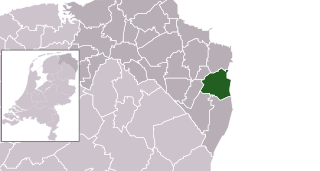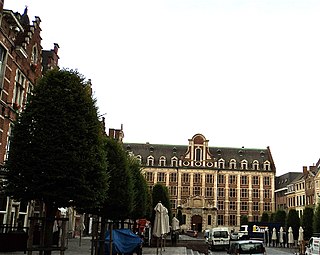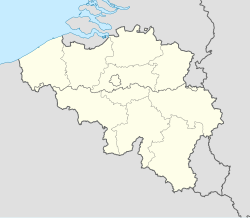
Limburg is the southernmost of the 12 provinces of the Netherlands. The province is in the southeastern part of the country, stretched out from the north, where it touches the province of Gelderland. Its northern part has the province of North Brabant to its west. Its long eastern boundary is the international border with the German state of North Rhine-Westphalia. Much of the west border runs along the River Maas, bordering the Flemish province which is also named Limburg. On the south end it borders the Walloon province of Liège. The Vaalserberg is on the extreme south-eastern point, marking the tripoint of the Netherlands, Germany and Belgium.

Limburg is a province in Belgium. It is the easternmost of the five Dutch-speaking provinces that together form the Region of Flanders, one of the three main political and cultural sub-divisions of modern Belgium.

Bellingwedde was a municipality with a population of in the province Groningen in the northeast of the Netherlands. Bellingwedde was established in 1968, when the municipalities of Bellingwolde and Wedde had merged. It contained the villages Bellingwolde, Blijham, Oudeschans, Veelerveen, Vriescheloo, and Wedde. After almost 50 year, Bellingwedde was disestablished in 2018, when the municipalities of Bellingwedde and Vlagtwedde had merged into Westerwolde.

Tongeren is a city and municipality located in the Belgian province of Limburg, in the southeastern corner of the Flemish region of Belgium. Tongeren is the oldest town in Belgium, as the only Roman administrative capital within the country's borders. As a Roman city, it was inhabited by the Tungri, and known as Atuatuca Tungrorum, it was the administrative centre of the Civitas Tungrorum district. The city is a member of the Most Ancient European Towns Network.

Rijkhoven is a village in the Bilzen municipality of the Limburg province in the Flemish Community of Belgium.

Weert is a village in the Bilzen municipality of the Limburg province in the Flemish Community of Belgium.

Hamal Castle is a castle in Rutten near Tongeren in the province of Limburg, Belgium, once the centre of the small independent lordship of Rutten. The castle was first mentioned in 1214. The current castle dates from the late 18th century.

Herkenrode Abbey was monastery of Cistercian nuns located in Kuringen, part of the municipality of Hasselt, which lies in the province of Limburg, Belgium.

Eigenbilzen is a village and former municipality in the Bilzen municipality of the Limburg province in the Flemish Community of Belgium. Eigenbilzen was an independent municipality until 1977 when it merged into Bilzen.

Brabantine Gothic, occasionally called Brabantian Gothic, is a significant variant of Gothic architecture that is typical for the Low Countries. It surfaced in the first half of the 14th century at St. Rumbold's Cathedral in the City of Mechelen.

Heritage registers in Belgium include immovable heritage such as World Heritage Sites, and National heritage sites, but also intangible cultural heritage. The agency responsible for keeping and updating inventories of immovable heritage is dependent on the region, as is the name for the object, which is called Beschermd erfgoed, Biens classés or Kulturdenkmal depending on the language of the municipality of the location.

Beschermd erfgoed is the official term to describe Flemish National Heritage Sites listed by law to protect and spread awareness of Belgian cultural heritage, specifically in Flanders. The term is also used nationwide to refer to national heritage sites. Because Belgium is officially a tri-lingual country, the other nationwide terms used in the rest of the country are the French term Bien classé and the German term Kulturdenkmal.

The Flemish organization for Immovable Heritage, or simply Onroerend Erfgoed is a cultural heritage agency sponsored by the Flemish Government. The organisation is split into four subdivisions; the former VIOE, which inventories Beschermd erfgoed in the Flemish Region; the agency "Ruimte en Erfgoed" which executes policy on heritage management and protection; the Ministry department of Town and County Planning, Housing Policy and Immovable Heritage, or Ruimtelijke Ordening, Woonbeleid en Onroerend Erfgoed (RWO), which supports the Minister of Culture on policy decisions; and Inspectie RWO, which is the inspection arm of the RWO.

Rutten is a village in the Tongeren municipality of the Limburg province in the Flemish Community of Belgium. The village is located in the Haspengouw region, and was a separate municipality until its merger into Tongeren in 1977.

Kruikenburg Castle is a listed building in the village of Ternat, Belgium. It was the seat of the lordship of Kruikenburg, which included the villages of Ternat, Sint-Katarina-Lombeek and Wambeek. A medieval foundation, the castle was extensively remodelled in the 16th and 18th centuries, giving it its current appearance. In 1662 the lord of Kruikenburg was elevated to the title of count. In the 20th century the castle became a house of the Lassalian Brothers.

St Anne's College was one of the colleges of Leuven University, now listed as built heritage of Flanders, Belgium.

Trinity College was one of the colleges of Leuven University, dedicated to preliminary studies in the liberal arts. The college was established by the university authorities in 1657 to replace the "Collège de Gand" founded by Frans van de Nieulande in 1559, which had closed in 1655 for lack of funds. Building began in 1658, under the supervision of Jan du Can and Adriaan van Mechelen, and from 1659 the college was housed on the Old Market. It was sometimes known as "Collegium Novum". The college was sequestered when the university was closed down in 1797 during the French occupation. The buildings were sold at public auction in 1802. The southern wing, added in 1684, was demolished in 1813. The final remnants of the 17th-century buildings were destroyed by aerial bombardment in May 1944. Since 1843 a Josephite secondary-school, Heilige Drievuldigheidscollege, has stood on the location.
CornilCacheux was a French pipe organ maker.

Armand Preud'homme was a Belgian componist and organist.
The Armand Preud'homme Museum was a museum in Peer, Belgium, that was dedicated to the Belgian composer Armand Preud'homme (1904-1986). From 1990 to 2018 the museum formed a combination with the Heemkundig Museum upstairs, called the Dulle Griet Museum.



















